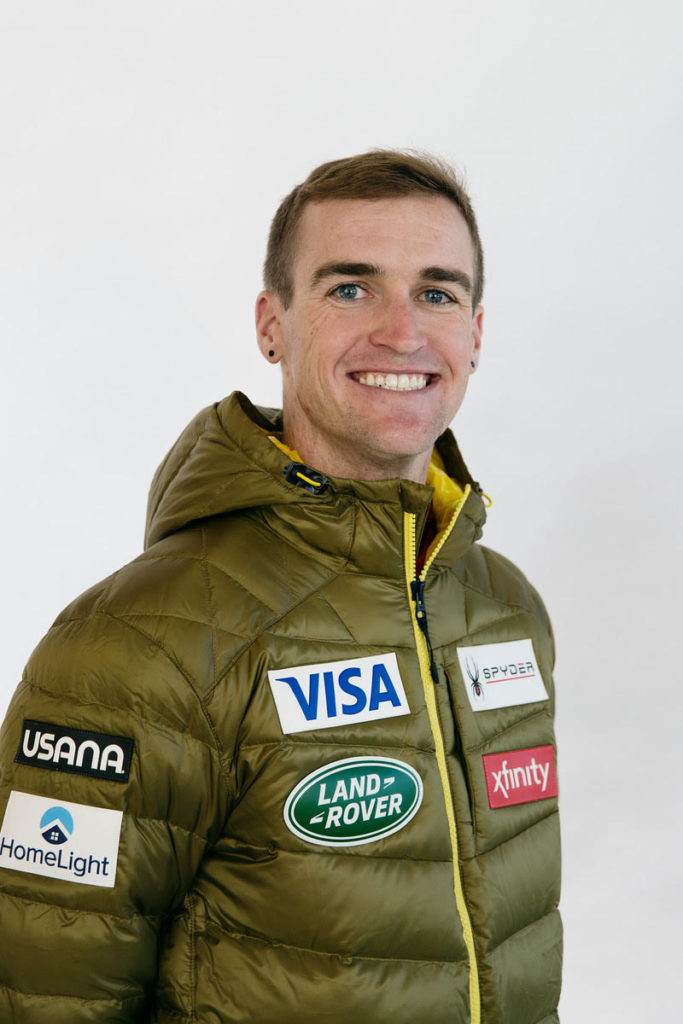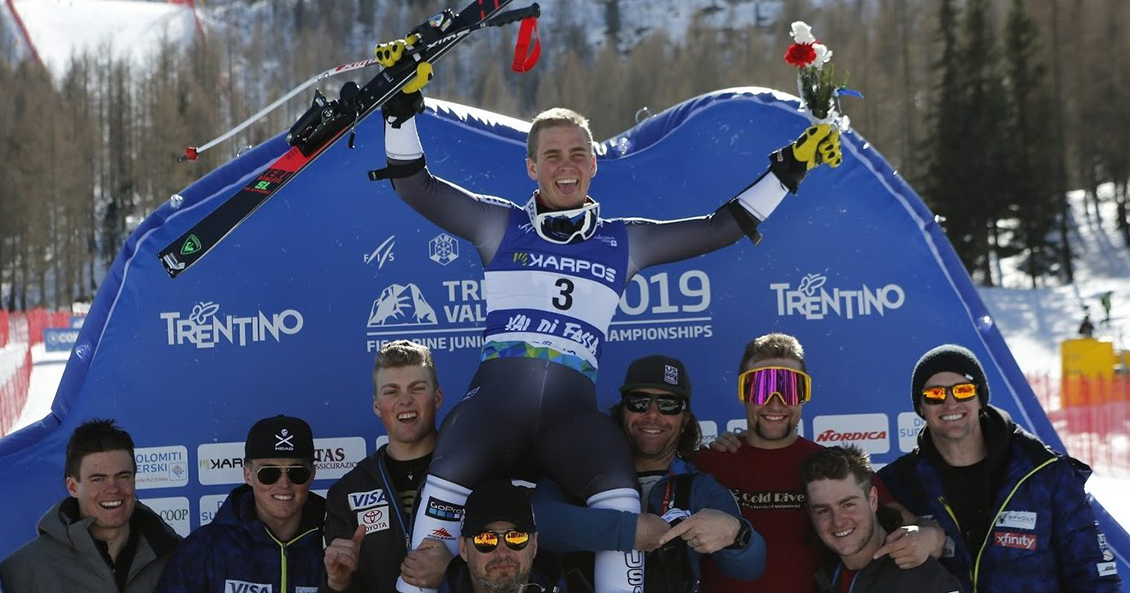Michael Bingaman (aka “Bing”) is the Athletic Development Coordinator for the men’s alpine team at U.S. Ski & Snowboard. After using Oura for 6 months with his athletes, Bing had a lot to share.
—
In the summer, Bing spends his days in Park City, Utah, where he prepares the men’s alpine athletes to be at the top of their game for their season. Once winter arrives, he travels the world with the team to help them maximize their performance.
His philosophy?
“To inspire, train, and educate my athletes in order to maximize their physical and mental preparedness because I care about the pursuit of personal as well as athletic greatness.”
His athletes compete in a sport where shaving a tenth of a second off a 2-minute run can be the difference in 1st place and 5th, and that’s where Bing comes in.
“Ski racing is an incredibly unique sport in that you can’t simply walk out your back door and train anytime you want. When we add up every single run they take on the hill and multiply that by the average length of the runs, we find that the literal time spent on the hill, in the gates, training our sport amounts to as little as 8-15 hours per year. Maximizing every single training opportunity is absolutely critical.
That’s where I feel I can have the biggest impact. In all honesty, I train them for their training.”
The team spends over 600 hours on dryland training, over 300 training on the mountain, and a few hundred hours travelling to venues.
Bing’s success stems from his ability to show athletes how seemingly small, day-to-day decisions can have a massive impact on their preparedness.
“The longer I’ve been in this field, the more puzzle pieces I see coming into play. A single metric like resting HR, for example, is just one tiny piece of a performance puzzle. How about their relationships back home? Or their sleep consistency? Or the fact that they’re not eating the right fuels in between training sessions?”
In 2019, Bing started searching for a more objective way to monitor his athletes’ training. That’s when he turned to Oura—drawn to the prospect of giving his athletes “a way of asking the body directly how it’s doing.”
What Did The Team Learn?
The Data Doesn’t Lie
For Bing, Oura data is invaluable for showing his athletes that they have the power to own their own routines. If they make choices that result in a poor night of sleep, they can see the undeniable impact on their body.
He notes, “An amazing thing the ring does is take a metaphorical mirror and spin it around so the athletes can see themselves with clarity. Once that happens – once an athlete has that data in front of him – it sparks massive change. For an athlete who wants to stand on a podium on the world’s stage, it simply has to.”
Here is an example of an athlete who began making positive changes when he observed his Oura sleep data. Over a two week period, prioritizing sleep and trending towards an earlier bedtime steadily increased his Readiness Score, Sleep Score, & Total Sleep. The result was a clear decrease in his nightly resting heart rate (RHR).

Screenshots taken from Oura Teams which enables athletes to share the information they choose with each other and their coach, empowering them to collaborate on data-based decisions about their training and lifestyle routines.
No Pain, No Gain
The team isn’t just chasing improved scores. Bing notes that, “. . . it’s not about getting the highest possible Readiness score or sleeping 20 hours every night. It’s about results.” Athletes have to maximize performance, which can mean taking a calculated hit to grow stronger.
Athletes are able to use their Oura data to reflect on the effects of their training days and the success of their post-training recovery.
Bing shares how he coaches athletes to think about their scores: “. . . after a particularly hard training day, I had a really low readiness score. Is that bad? No. That’s expected. I’m looking for signs of balance because I still had a high sleep score, which showed that though my body took a beating, I was doing a good job of prioritizing my rest and recovery.”
Below is an athlete who went through an intensive, 5 day “microcycle block.” The data shows a pattern of strain during training (declining Readiness, Sleep Score and Total Sleep combined with an increase in RHR), followed by a clear pattern of recovery afterwards (increasing Readiness Score, a rebound in sleep, and RHR returning to baseline).

Not All Rest Is Equal
“There are many different types of recovery that take place during unload weeks or time off. Sometimes you just need to get away and have some fun, something of a mental recovery. . . No matter the goal, it’s important to recognize the implications your actions have on your recovery during this time, and to prioritize your actions appropriately.”
Bing makes it clear that breaks are all about timing. “If you get a week off before heading into a high-volume and/or high-intensity camp. . . your down time should place a massive priority on physical and mental recovery.”
Here is an example of an athlete that took a week off. His Readiness Score, Sleep Score, and Total Sleep were trending up as signs of recovery. Although the athlete had a tight bedtime window most days, Bing points out, “. . .hey, we’re all human, and on day 3 (where you see low scores across the board), this athlete had a night out, which I would call something of a mental recovery. All good! Once the unload week ended, you can see that he was ready.”

The Road Takes Its Toll
“Travel, especially international travel, wrecks sleep patterns and takes multiple days, if not a week or more, to bounce back from. Did we know this already? Yes, but now we have it quantified.”
Multiple times a season, athletes are shifting back and forth from the U.S. to European timezones, having to change their entire routine about once every 6 days. So, quality rest is scarce.
“The reality is that international travel is not optional for our sport. The question then is how to optimize our travel and our physiological adaptations to the new time zones. Life on the road creates a whole host of challenges. The eves of most World Cups have massive parties going on right outside your window for example, making sleep all the more challenging. Additionally, long travel days (sometimes 7+ hours in the car or 30+ hours on international travel days) . . . often end in collapsing onto some unfamiliar bed. These little changes have huge implications in our training and race day performance.”
Here’s an example of an athlete who made the trip to Europe, and his Readiness score, Sleep Score, Total Sleep, and RHR took a hit.

Bing and his team have learned that it can take an athlete 5-8 days to reach their prime when traveling internationally. This means adjusting their routines pre-race to make room recovery.
Bing advises, “. . . training intensities both on the hill and in the gym should be cautiously and smoothly ramped up. I’m lucky that my coaches understand this, and the data from the ring further drives the point home. . . it’s important to realize that being on the road does cause stress and does make recovery and adaptation a little more challenging.”
What’s Next?
Bing and his team are just getting started. Oura data is just one piece of their training regimen. Ultimately, the occasional low Readiness score or one night of missed sleep is no sweat—they’re looking for big-picture trends and habits that can give them an extra edge.
“We have more control over our sleep and over our overall preparedness than we realize. Call us crazy, but if that means bringing our own pillows from home on the road to maximize our recovery, we’ll do it.”

Bing’s Key Tips For Athletes:
- Control what you can and prioritize sleep hygiene: “Time your meals well, shut the electronics down at least 1 hour before bed, build in wind-down techniques (reading, meditation, yoga, etc), and bring a pillow from home if you need it! One of the strategies we’re looking to implement is pairing athletes who have similar sleep patterns. Similar sleep schedules helps optimize both athletes’ routines.”
- Aim for consistent bedtimes and wake times: “The more consistent we are with this, the better opportunity we give our body to reach high levels of Deep Sleep and REM sleep, which are critical for recovery. Oftentimes, it’s as easy as saying “no.” “No” to late meals,” “No” to the athlete who always asks if you want to play video games. A “No” can empower your big “YES”— “YES” to optimizing your recovery and your performance.”
- Maximize travel-day habits: “Begin shifting your bedtime a few days prior to international travel. Though the west-coaster doesn’t need to go to bed at 12:00p PST to simulate a 9:00p CEST bedtime, every little bit will count! Once your travel days arrives, take control of your own meal timing, use eye masks and ear plugs when needed, sleep on the flight (or stay awake, depending on where you’re travelling), and utilize properly-timed caffeine and/or melatonin to help you acclimate.”
Read More:
What’s Your Oura Story?
Everyone’s story is unique. Share yours with the Oura Community, or just give the Oura Team an update of where you are in your health journey!











